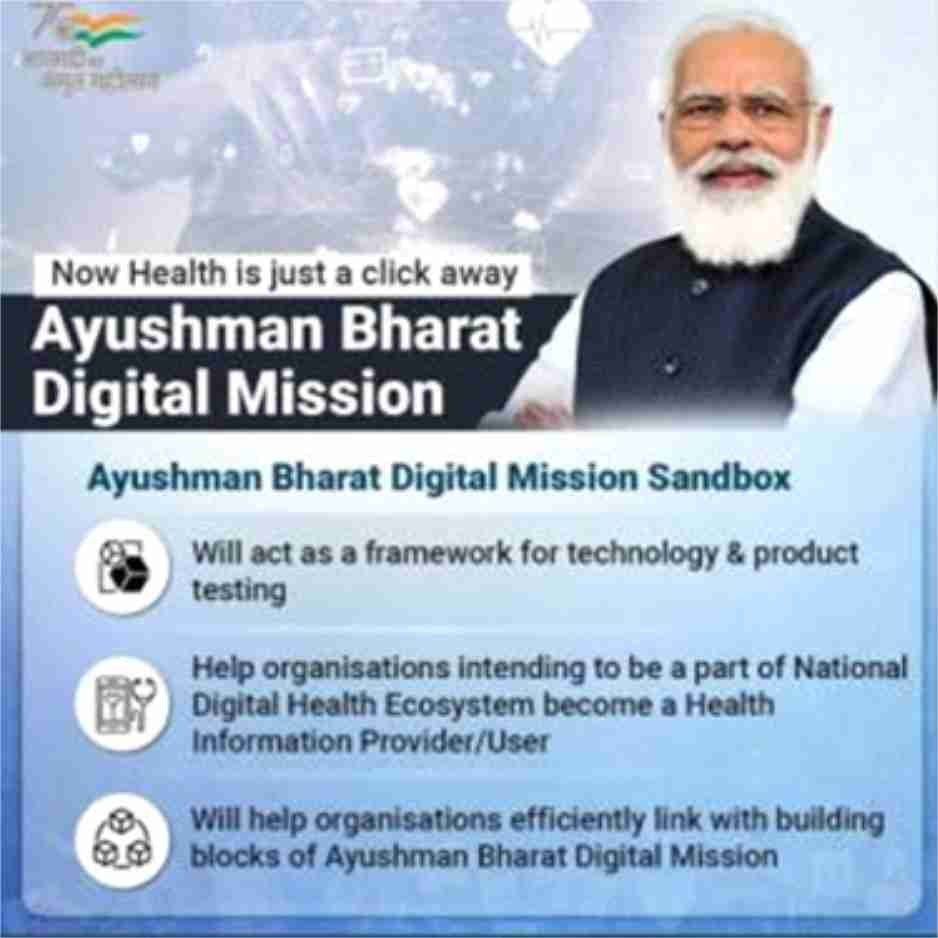Ayushman Bharat Digital Mission
GS 3: Health
The Hindu
Context:
- The Prime Minister has launched the Ayushman Bharat Digital Mission.
Features:
- It involves creation of not just a unique health ID for every citizen, but also creation of digital healthcare professionals and facilities registry.
- Through the digital health ID, the patient himself and the doctor can also check old records if needed.
- It will enable individuals to discover hospitals, laboratories and pharmacies across the country — the health record of every citizen will be “digitally protected”.
- There will also be registration of colleagues like doctors, nurses, paramedics.
- The hospitals, clinics, labs, medicine shops in the country, all these will be registered.
- This mission will play a big role in overcoming problems faced by the poor and middle class in the country in accessing medical treatment.
- It will create a seamless online platform to access treatment records, and enable faster and effective treatment.
- It will “increase the ease of living” along with “simplifying the procedures in hospitals”.
- The doctors and hospitals will be able to use this platform to provide remote health service.

Pusa Basmati
The Indian Express
GS III: Agriculture
Context:
- The Indian Agricultural Research Institute (IARI) has developed the country’s first-ever non-GM (genetically modified) herbicide-tolerant rice varieties- Pusa Basmati 1979 and Pusa Basmati 1985.
- GM technology allows the transfer of genes for specific traits between species using laboratory techniques.
Significance:
- These varieties can be directly seeded and significantly save water and labour compared to conventional transplanting.
- These varieties contain a mutated acetolactate synthase (ALS) gene making it possible for farmers to spray Imazethapyr, a broad-spectrum herbicide, to control weeds.
- Imazethapyr, effective against a range of broadleaf, grassy and sedge weeds, can’t be used on normal paddy, as the chemical does not distinguish between the crop and the invasive plants.
- The ALS gene in rice codes for an enzyme (protein) that synthesises amino acids for crop growth and development. The herbicide sprayed on normal rice plants binds itself to the ALS enzymes, inhibiting their production of amino acids.
Right to Govt. Aid
The Hindu
GS II: Indian Polity
Context:
- The Supreme Court said that an institution’s (whether run by a majority or minority community) right to government aid is not a fundamental right.
About:
- Both kind of institutions have to equally follow the rules and conditions of the aid.
- An institution is free to choose to accept the grant with the conditions or go its own way.
- If an institution does not want to accept and comply with the conditions accompanying such aid, it is well open to it to decline the grant and move in its own way.
- On the contrary, an institution can never be allowed to say that the grant of aid should be on its own terms
- If the government made a policy call to withdraw aid, an institution cannot question the decision as a “matter of right”.
- The government aid is a policy decision. It depends on various factors including the interests of the institution, ability of the government to understand the exercise, financial constraints and deficiencies etc.
Constitutional Provisions:
- Article 30(2) states is that on the ground that an institution is under the management of a minority, whether based on religion or language, grant of aid to that educational institution cannot be discriminated against, if other educational institutions are entitled to receive aid.
Akash Prime Missile
The Hindu
GS III: Defence
Context:
- The DRDO tested a new version of the Akash Missile, Akash Prime.
About
- It is a surface-to-air missile.
- In comparison with the existing Akash System, Akash Prime is equipped with an indigenous active RF (radio frequency) seeker for improved accuracy.
- Other improvements also ensure more reliable performance under low temperature environments, at higher altitudes.

7th Edition of Sanitation Survey
PIB
GS II: Government Scheme
Context:
- The Housing and Urban Affairs Ministry launched the seventh edition of the sanitation survey of cities conducted by the Swachh Bharat Mission-Urban.
About
- As a part of the celebrations of 75 years of Independence next year, the sanitation survey would have the theme of “Azaadi@75” and take feedback from senior citizens regarding cleanliness in their cities.
- Campaigns such as ‘Kachra Alag Karo’ is aimed at reinforcing the practice of source segregation which is the cornerstone of effective waste management.
- It was launched by MoHUA in 2016 to rank cities on cleanliness parameters in 73 cities and it is the world’s largest urban cleanliness survey conducted by Swachh Bharat Mission-Urban (SBM-U) covering over 4,000 ULBs.
- Designed with ‘People First’ as its driving philosophy, Swachh Survekshan 2022 is curated towards capturing the initiatives of cities for the overall welfare and well-being of frontline sanitation workers.
- The Mission is also committed to continuously engage with citizens to improve the quality of public sanitation infrastructure and services.
Foreign Trade Policy
The Hindu
GS III: International Trade
Context:
- The central government has decided to extend the existing foreign trade policy till March 2022.
Significance
- The Foreign Trade Policy (FTP) provides guidelines for enhancing exports to push economic growth and create jobs.
- Under this policy, government provides incentives via different schemes such as Duty Free Import Authorisation (DFIA) and Export Promotion Capital Goods (EPCG).
- The government is focusing on the target of $1 trillion exports, each for goods and services.
- India needs to move from trade deficits to trade surpluses.
- In recent times, India has received massive inflows of foreign direct investment (FDI).
Z-Morh Tunnel
The Indian Express
GS III: Infrastructure
The 6.5 kms long Z-Morh Tunnel is set to be open for controlled traffic by November, 2021.
About
- It is all-weather escape tunnel which connects Srinagar and Sonmarg, and supplies are maintained throughout the year.
- The tunnel is being built at a cost of Rs 2,300 crore.
- Need:
- At 8,960 feet, Sonmarg is covered in snow in the winter months, forcing local residents to shift to Srinagar side.
- All commercial activity comes to a halt during winter, and due to avalanches, connectivity on Srinagar-Leh highway gets blocked.
Other points
- Beyond Sonmarg, the 13.5-km Zojila tunnel, which will provide all-weather connectivity between Srinagar and Ladakh, making for a strategic asset for the Army, may also be completed ahead of its scheduled target of 2026.
- Total cost: Rs 4,600 crore
- It is an all-weather alternative to Zojila pass, which closes down in winter, halting all transport, including troop movement and critical Army supplies between Kashmir and Ladakh.
- This bi-directional tunnel is the longest in Asia.
GI Tag to Assam’s Judima Wine Rice
PIB
GS III: Agriculture
- The Geographical Indication (GI) tag has been give to Judima, a home-made rice wine of Assam’s Dimasa tribe.
- It has become the first traditional brew in all of northeast to bag a Geographical Indication (GI) tag.
- This is the second product from the hill districts of Karbi Anglong and Dima Hasao to get GI tag.
- Earlier, Manipur’s most famous Hathei chilli and Tamenglong orange were awarded the GI Tag.
About Geographical Indication (GI)
- It is an indication used to identify goods having special characteristics originating from a definite geographical territory.
- GI tag in India is governed by Geographical Indications of Goods (Registration & Protection) Act, 1999. It is issued by the Geographical Indications Registry (Chennai).
- The registration of a geographical indication is valid for a period of 10 years.
- The GI protection in India leads to recognition of the product in other countries thus boosting exports.
- It is also a part of the World Trade Organisation’s Trade-Related Aspects of Intellectual Property Rights (TRIPS).
Quarterly Employment Survey (QES)
PIB
GS III: Indian Economy
The Union Labour and Employment Ministry has released the report of first quarter of Quarterly Employment Survey (QES) part (April to June 2021), of the All-India Quarterly Establishment-based Employment Survey (AQEES).
- It is prepared by the Labour Bureau.
About
- It provides updates about the employment and related variables of establishments, in both organised and unorganised segments of nine selected sectors.
- These sectors like Manufacturing, Construction, Trade, Transport, Education, Health, Accommodation and Restaurant, IT/ BPO and Financial Services, altogether account for a majority of the total employment in the non-farm establishments.
- Of the total employment estimated in the selected nine sectors, Manufacturing accounts for nearly 41 percent followed by Education with 22 percent, and Health 8 percent. Trade as well as and IT/BPO each engaged 7 percent of the total estimated number of workers.
- There are two components under AQEES, Quarterly Employment Survey (QES) and Area Frame Establishment Survey (AFES).
- QES has been initiated to compile relevant data from about 12,000 establishments selected through a sampling design to represent each of the nine sectors within each state/ Union Territory, as also each size-class (range of number of workers) within each sector-State/ UT.
- Area Frame Establishment Survey (AFES) covers the unorganised segment (with less than 10 workers) through a sample survey. AQEES will provide a consolidated picture with both the organised and the unorganised segments of the non-farm economy.

